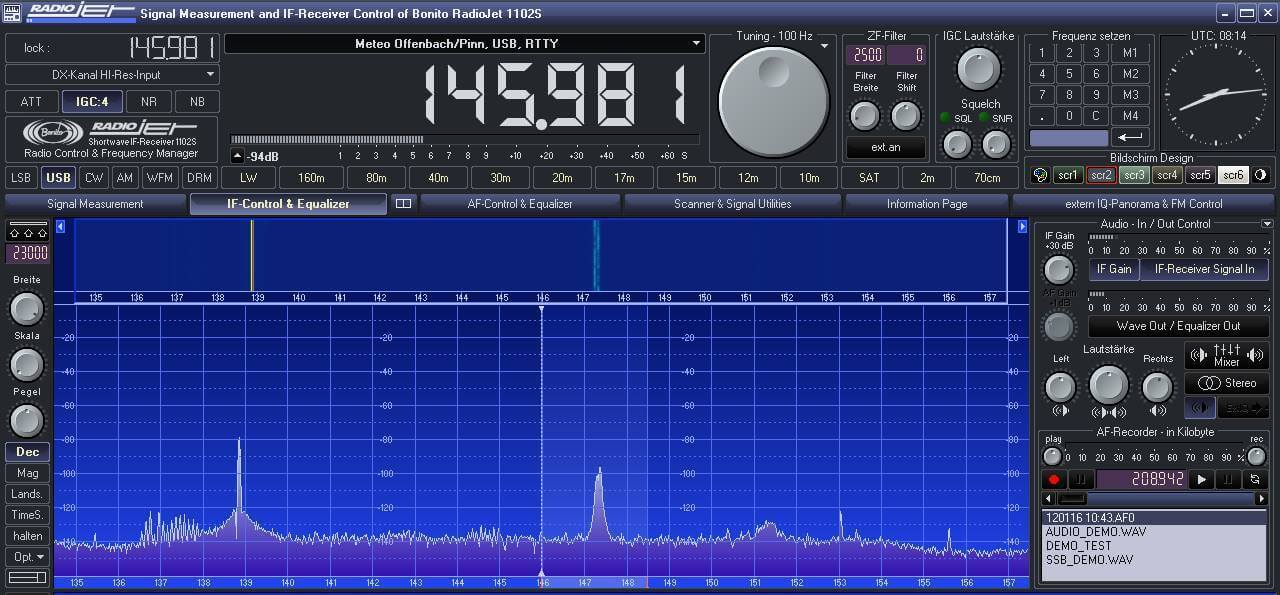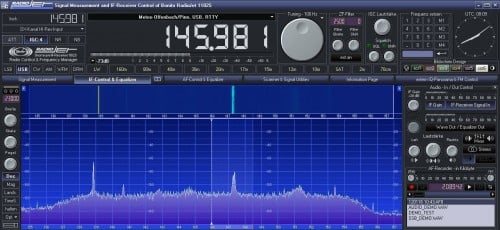Lowering the Noise Floor on HF with High Quality Coax
Bonito is a company that sells various products such as their own small active antennas. Some examples are the Bono-Whip (20kHz – 300 MHz), GigaActiv (9kHz – 3 GHz) and the MegaLoop (9kHz – 200 MHz).
Over on their blog they’ve uploaded a post titled “why even good antennas need good coax cable”. The post explains why high quality heavy shielded coax cable may be required to receive HF signals in noisy environments. The author writes how even placing an antenna in a quiet area outdoors may not work if the coax is still run through an high interference environment, such as through a house.
Typically RG58 cable is most commonly used with HF antennas. However, the author noticed that when using RG58 he was still receiving FM stations, even though the antenna that he was using was a MegaLoop with a built in broadcast FM filter. After switching his RG58 cable to H155 coax, the FM station disappeared. H155 coax is low loss and designed for GHz level frequencies, so it has much better shielding from its tighter braid.
The images below also show the difference in noise floor the author saw after replacing all his RG58 with H155 coax.




STEREN is great cable connector. This coax cable’s length of 100 feet makes it appropriate for even high-powered applications. It has a remarkable construction that makes it appropriate even for the worst circumstances.
The better shielded coax “may” masking a bigger problem with the overall system!
The better shielded coax may be attenuating high power higher frequency signals (e.g. VHF FM Broadcast) outside the band of interest (which is HF <30MHz). Therefore, you get a lower noise floor but why? The problem may be poor filtering at the receiver's input and/or poor receiver dynamic range. Even though the VHF interfering signals are outside the band of interest, in a poorly frequency selective (poorly filtered) and/or poor dynamic range (easily compressed) receiver, the strong VHF signals will intermodulate (mix), this can cause unwanted spurious signals and an increased noise floor.
Another case of where the antenna and/or antenna feed (coax cable) can cause a high noise floor is where mismatches and/or resonances in the feed/antenna cause the receiver to oscillate, usually at very high frequencies. The oscillations will result in an increased receive noise floor in a range far outside the frequency of oscillation. This is a sign of an unstable receive system. One combination of antenna/feed will oscillate, a slightly different combination will not. The use of baluns and/or chokes or isolators as well as good grounding practices may fix the problem, but a better solution is to properly design the system to be unconditionally stable in the .
So yes, "better" coax may give a lower noise floor – but it may be just putting a band-aid on an already very sick system to begin with!
At 145MHz the attenuation of H155 is lower by 6,6dB/100m compared to a RG58 cable.
So 220m(!) of RG58 cable has been replaced by H155!?
@JMG
1. The article talks about HF which ends at 30 MHz. While you are correct that at 144 MHz, which is VHF and not HF, the attenuation increases, it is of no consequence since the article discussed use in the HF Band.
2. The point made by the article was insuffcient shielding and not excessive attenuation, which is <= 1 dB at 30 MHz for 100 m cable of 9201 Coax – RG-58/U. There is nearly no difference between H-155 and a high quality R-58 RF-200 Riser coax from Belden.
From which manufacterer is the bad attenuation you quote for RG-58? Just Belden alone listed when checked for my reply 15 different RG-58 types.
The RG-58 RF-200 Riser has like the H-155 the benefit of an additional AL-PET-AL shield below the braid, the RG-58 RF-200 Riser braid shield has 95% coverage, while the H-155 has only only 80% coverage
The 9201 Coax – RG-58/U Type has only 80 % coverage and lacks the the additional AL-PET-AL shield below AL-PET-AL shield below the braid.
PS.: I got the attenuation by by applying linear interpolation between the provided data points.
1. RG58 C/U specification is 17dB/100m at 100MHz.
2. Your image is for 145MHz. The measured difference of signal level by 19dB is for RG58 versus H155 cable. This indicates a cable length of 220m.
3. The image does not correspond to any other frequency.
4. Shielding efficiency should be measured with a terminated antenna cable.
Did you read the article it’s about reception of SW or lower frequencies. The RFI he had, even when he switched from electrical to predominently magnetic antennas. Despite filters in his 9 kHz to 200 MHz antenna, FM BC interference was only gone when he improved the cable shielding by replacen a not defined version of RG58 with the H155.
Quote ” Now, I have a lot less noise and considerably fewer interferences on medium wave” (below 1600 kHz).
The VHF screen shots were to show the improvement in shielding, not that he was writing about VHF.
I agree with the need for good shielding after I had a few contacts on 2m,about 5 km away, when my 100 W PA was attached to a 50 ohm dummy with low return loss via 50 cm single shield RG58. o).
the quote talks about HF which is below 30 MHz,.
Therefore the lower attenuation of cable like RG8x, RG-213 with frequency will not be significantly different, unless you want to receive above 30 MHz.
Inefficient shielding on cheap/fake coax cable is as staed above a real problem. The worst fake RG-58 that I saw had something something like 1 strand of wire every mm in the shielding.
Depending on where you live there may be even more options for double shielded cable, check the HAM-radio dealer in your country.
Then there is the option for cable with a solid cooper shielding like cellflex or flexwell, a good introduction to caox can be found on http://www.rfsworld.com/userfiles/pdf/technical-description-rfcables.pdf.
One question from me on selecting the correct impedance for coax is, what is the input impedance of the SDR-Sticks?
For SDR-Sticks that have a F-connector or a TV-connector I would have assumed the impendence to be 70 Ohm. Therefore double shielded TV-SAT cable of good quality are much cheaper solution and provide good shielding and lower loss than RG-58.
Even if SDR-Sticks use SMA connector, is the impedance 50 Ohm or higher?
The only reason to assume 50 Ohm is when the SDR-Stick has a 4 Pin amplifier in front which has 50 Ohm. Then the amplifier would define the impedance.
What are your thoughts?
All coax cables are not created equal.
Cheap RG-58 from your local discount supplier will not be the same quality as a good brand name (i.e. Belden or Alpha) from a reputable dealer and cost will like wise be higher for the better quality cable. The cheaper cables which claim to be RG-58 or RG-8 or RG-213 will have a shield that is less,sometimes much less coverage than the real deal. Times Microwave makes a very good quality coax and in the RG-58 size is their LMR-195 series cable which is also double shielded and likely very close if not the same specs as the H155.
typically the larger cables provide lower loss which is much more important the higher in frequency you go – into the VHF/UHF and SHF ranges. for example RG-213 or preferably LMR-400 would be a much better choice at 400 to 1000 MHz frequencies than RG-58 or LMR195. Of course the larger cables can be used at much lower frequencies as well. These larger cables are more difficult to handle as they cannot be bent around small corners and are generally much “stiffer” than the smaller cable.
and there is much more to cabling than just the cable. common mode chokes (i.e. clamp on ferrite beads and baluns and un-un’s types of transformers – do a search) are very useful in helping to reduce noise as are AM broadcast band and FM broadcast filters. And too is good grounding techniques.
Quality quad shield RG 6 also works very well for simple receive antennas. I use this type of cable quite a bit. It is 75 ohm but most radios never know the difference. If you are concerned a simple impedance transformation transformer is very easily made.
One of my quietest receive only antenna’s is a variation of Dallas Lankfords Low Noise Vertical except that the Vertical portion in my case is a 60 foot wire run along the top of the fence in the back corner of my lot about five feet off the ground. Feed from the antenna to my radio is via outdoor rated CAT5 network cable using one twisted pair of the cable. Do a search for Dallas Lankford low noise antennas, you should find much food for thought.
there are also other variations of good receive only antennas – search for BOG antenna (beverage on ground), flag antenna or pennant antenna or K9AY antenna. Simple pieces of wire strung out do work OK but sometimes it requires a bit more effort to get a really good antenna that works well.
cheers, Graham
H155 is what they sell in their online shop but what about double shielded RG-6?
Yes, this is an example what a difference the signal strenght and Signal To Noise ratio. Neverthless, assuming that any mismatch between antenna and coax. In this case, the sielding is not all point equal to ground, witch means to a coax shielding preset RF. But one warning : my location (east Europe) a large amount of counterfeit (marked as H155) coaxial cable, sold to even the specialist shops. Assuming not only here. Highly recommend any “H155” users, brag an antenna analyzator and test the coax (distant end on dummy load) and if your analyzer capable the “Coax Loss” test (MFJ 259 has yes), make sure the loss. Sorry my worth english.
Hmm, never seen H-155 in ham radio before. Seems to be a bit niche to networking. And all of the sites I come up with on Google seem to point to European sellers.
RG213 or RG-8 definitely has less loss than RG-58 at most frequencies, and also generally will be (1) made with a copper shield for easy soldering and (2) is easy to get hold of in the US (Radio Shack still carries RG-8X, the not-so-great-but-better-than-RG58-variety) and (3) has roughly the same velocity factor as RG58, so it ought not to create problems if the upgraded system involves phasing lengths.
However, I’m hardly a coax expert. I assume that there is roughly a 1:1 relationship between loss figure (signal leaking out) and noise (signal leaking in). Is this a reasonable assumption or are there other factors that make H-155 superior to RG-8 or RG-213?